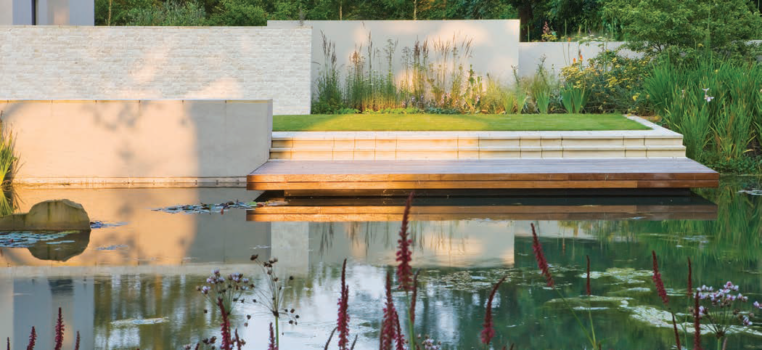Patricia Tyrell, Chairperson of the Garden and Landscape Designers Association, reviews the hugely successful 20th-anniversary design seminar
The GLDA’s 20th Anniversary Seminar ‘Ebb & Flow’ promised to be the unmissable event of the year and it did not disappoint. This is the 20th year of the GLDA seminar and very appropriately, one of the most successful and thought provoking seminars held to date. A rare opportunity to get an insight into the global flow of ideas and influences in landscape design, past, present and future. Many very interesting areas were covered from the historical and cultural role of the garden in India, the part played by Chinese porcelain in influencing garden and landscape ideas; the influence of the Dutch through plant hunting and introductions, and surprisingly, through their production of delf. More recently the influence of the ‘Dutch wave’ or ‘New Perennial Movement’, the spread of the English garden style and a fascinating insight into a new and emerging style coming from the east, inspired by the past, but very much of the future.
Our first speaker was Cor van Gelderen from the Netherlands. The title of his talk ‘East travels West’ Cor is a fifth-generation plantsman from Firma C. Esveld in Boskoop, Netherlands established in 1865 and one of the world’s great specialist nurseries, famous for its conifers, maples and other woody plants. Van Gelderen spoke in detail on a small number of species, yet his talk was fascinating, informative and most of all entertaining. He focused initially on Philipp Franz Von Sieboldt (1820-1865) and his introductions, brought from Japan in the 19th Century, specifically focusing on his introductions of Hydrangea and Camellia spps. Sieboldt’s first introduction was Hydrangea macrophylla ‘Otaksa’ named after his Japanese mistress (his wife was not happy!). Cor has 750 hydrangeas in his collection and has written a book on the subject, but considers them a little boring as they are a bit plump!
With an intimate knowledge of his subject van Gelderen brought us through his favourites and his ‘not so favourites’. And then on to a subject very dear to his heart Acers of which he has built up a collection of 1000 different varieties. Also a designer, his pictures suggested lovely combinations to take note of – Bamboo and Tetrapanax papyrifera for striking textural effect or a simple combination of Acers, Ferns and mosses. Some of his favourite maples were mentioned: A. ‘Beni-otome’, A. Inazuma and A. Westonbirt Red for its spectacular autumn colour.
The second talk of the day was Xiaowei Ma and Xiao Ying Xie. Their titles – ‘Western Influences on Modern Chinese Landscape Design’ and ‘Heartprint’ respectively Both landscape architects have their own practices in China, Xiaowei in Shanghai where he founded the AGER Group in 2001 and Xiao Ying in Beijing. Her practice is called View Unlimited. Their work is included in a recently published book ‘30:30 Landscape Architecture’, as is that of Mrs. Xiao Ying Xie. The book features some of the best-known and most established landscape architects in the world as well as the best and brightest of the next generation of designers.
Xiaowei, very much on the theme of the seminar, commenced by taking us through a broad sweep of Chinese history and how the various shifts in dynasties and trade routes brought a strong Chinese influence to
“Xiaowei told us that the largest landscape contracting business in China has 20,000 employees it gives some idea of the scope of the work being carried out here”
the West and how through its trade in porcelain was more responsible for the idea of the Chinese garden in catching the imagination of Europe than trips made by explorers to China.
Xiao Ying then showed us some work from the more cutting-edge practices in China including work by Kongjian Yu of Turenscape.
Following on from this Xiao Ying took us through some of her astonishingly beautiful work in Beijing and Shenzen using video as her presentation format. This included a large park, housing, urban redevelopment projects. She spoke in Chinese that Xiaowei translated.
These were very visual and maybe the best way to describe her work is this excerpt from her description of a project in Shenzen.
“The landscape design approaches in this particular project are to maximize the utilities of limited green spaces via compound functions and to control the landscape vistas through effective sculpting of slopes. It is a subjective adaptation of the abstract metaphors from traditional Chinese landscape painting: “distance (ping-yuan), depth (shen-yuan) and horizons (gao-yuan)”, multiple perspective views in one image.“
The scenes of her parks and public spaces being heavily used were a testament to the effectiveness of her approach to her work. When Xiaowei told us that the largest landscape contracting business in China has 20,000 employees it gives some idea of the scope of the work being carried out here.
After Lunch Aniket Bhagwat spoke. His title: ‘Mending apparatuses; Gardens of the Future Past’
He is a third generation Landscape Architect with a large practice in Mumbai and Ahmadabad, Prabhakar Bhagwat Architects and Landscape Architects. He began with a look back at the origins of the garden in India and its significance. The earlier garden was deeply connected to the land and cultural ethos. The loss of this cultural significance came about through the influence of British colonialism, bringing with it the ‘English Garden’ style.
“The earlier notion of garden got altered and transformed from the garden as a metaphysical and cultural room to the garden as the space “outdoor”. Somewhere we slowly but irrecoverably lost the idea of the garden as we knew it. The garden became a setting in which a built object was placed, divorced from each other.”
After setting the scene in part one, in part two he brought us through some of his projects, presented as short films with enchanting and exotic background music. Not only were people fascinated by the projects, but they were also totally intrigued by the music with many asking for more information on it. In most of the projects, the garden and the architecture were both designed by the firm. The videos of each project were rich in detail, it left one wanting to see more; everything was questioned, everything lovingly detailed, and nothing left to chance.
Aniket finished with a poetic definition of what a garden is:
The garden is an apparatus
By which to see self
Shadows of self
A future self,
Or a self that may never exist;
The garden is an apparatus
By which to navigate the world
Rhythms of life
And cycles of death:
Meanings of patience and piety
The garden is an apparatus
In which to enact life
Its joys and sorrows
Its whimsical madness
And scholarly pursuits.
The garden is a rusty apparatus
It’s time to mend it
And make it the centre of our being
Once more
Last to speak was Andrew Wilson of Wilson McWilliam Studios in the UK. Though a man with many talents from writing to teaching and design, his talk focused mainly on his show-gardens, first at Chelsea Flower Show where his cutting-edge design combines with beautiful sweeps of perennial plantings; an influence from our Dutch neighbours. Andrews planting palette has changed over the years when first starting off he would have used 95% woody plants now he uses 95% grasses/perennials. From Chelsea, he moved East to his first show-garden in Singapore, ‘Sacred Grove’ a visually striking garden on stilts, for which he won ‘Best in Show’. He is about to embark on another garden for the 2016 Show in Singapore, ‘Silence’; learning from 2014 the garden is more insular, using a core-ten steel screen and a Morse code message punched out of the steel.
As his studio embarks on more projects in the east he will no doubt be bringing with him western style influences, particularly in the area of planting design in which Andrew is a master.
The day was indeed a very special one, with much on which to reflect. Particularly timely in Ireland as we struggle to find a distinct design language that is uniquely Irish and yet reflects the many influences that ‘Ebb and Flow’ to our shores. ✽
  |










